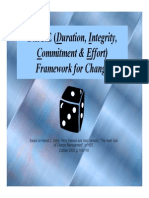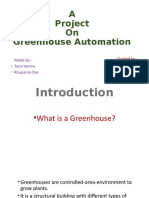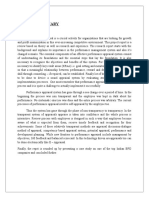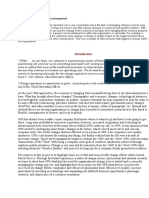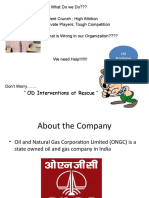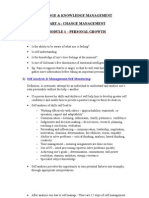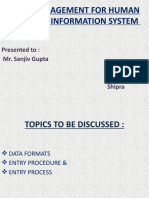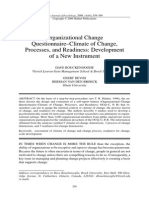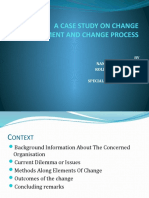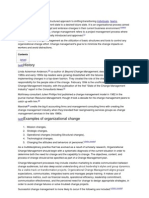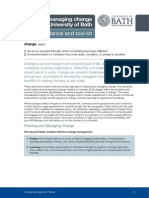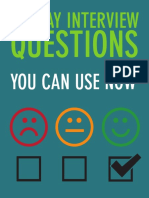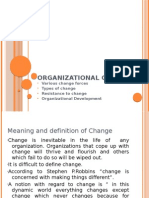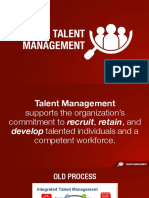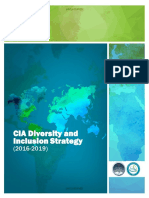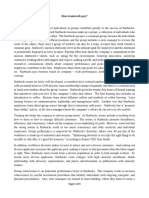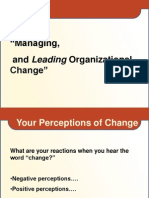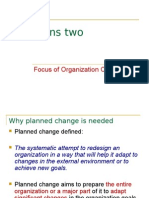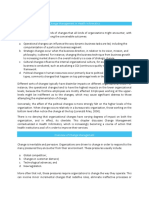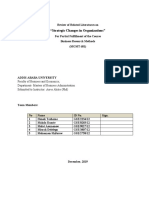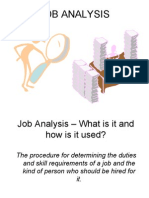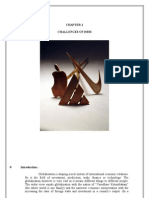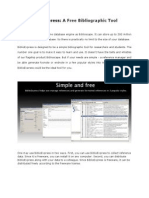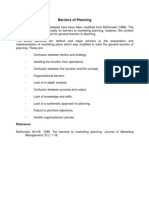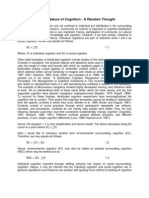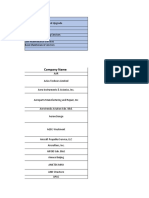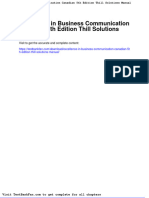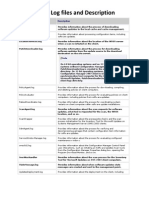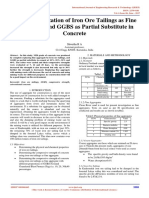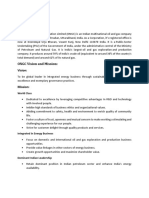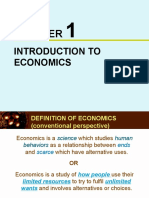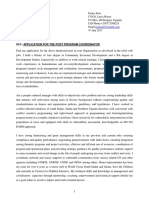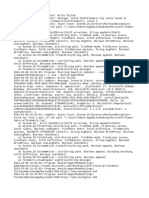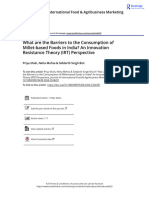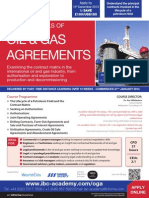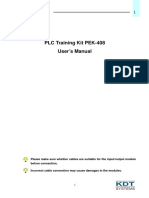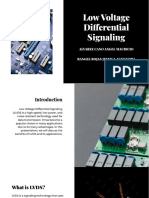Change Management: A Case Study
Change Management: A Case Study
Uploaded by
praydocCopyright:
Available Formats
Change Management: A Case Study
Change Management: A Case Study
Uploaded by
praydocOriginal Title
Copyright
Available Formats
Share this document
Did you find this document useful?
Is this content inappropriate?
Copyright:
Available Formats
Change Management: A Case Study
Change Management: A Case Study
Uploaded by
praydocCopyright:
Available Formats
Module 5P3: Change management Case Study A: Stepping on two boats
Managing the transition period, optimizing short-term performance, keeping the highest percent of talent, and integrating processes and systems are some issues that need to be tackled as facilitator for change (here it is the case of merger and acquisition). My job will be easing the transition and focusing employees besides managing above issues as these are having direct bearing on profitability, retaining top talent and confidence in leadership decisions. Success depends ultimately on the effective use of people. The strategic triangle for change management The legitimacy and support comes from authorizing environment and, and hence I need to take the top management into confidence. Also I will keep into my mind about the value of the organization in terms of mission, goal and objectives. Operational capacity is another factor which I will consider in the process of change.
Legitimacy and Support
Comes from authorizing environment
Value
Mission Goal Objective
Operational capacity
Ability to deliver result
Other thing I will infuse in the system is discussing the urgency of change, building guiding team, getting the vision right, ensuring two-way communication (top down as well as bottom up), empowering action, building a strong consultative environment and sticking to change.
Another thing I will keep into mind is cycle of change which deciding on my actions.
Ensuring effective communication: As effective internal communication is very important, I will be sincere with employees and let them know the reasons for the change. Communicating regularly to staff will boost confidence, improve morale and prevent rumours from running wild. Hence I will implement an effective communication plan at a very early stage of change. This will help to make all the difference when it comes to communicating with and reassuring employees. This will let the employees focus on how the change affects them personally. Also I will help them understand the big picture by communicating business as well as the advantages to the company and to them. Frequent communication will reduce needless anxiety and confusion among employees. I will also try to build morale and minimize disruption by providing clear, honest, frequent communication throughout the transition. Also I will ensure that true two-way communication opportunities to answer the questions posed by employees to reduce resentment and frustration. For this I will organize open sessions in an interactive setting to support their needs, manage expectations, and prevent undue disruption. Also I will have a communication channel open with the superiors to provide them regular feedback and take their confidence. Essentially I will create a climate of trust where employees will feel accountable and work together effectively to cope with the change.
Tackling with the rumours: During merger and acquisition (M&A), the rumours are rampant and need to be managed effectively. The rumour about job-losses is usually most important to counter honestly and at an early stage. Inconsistent information about the extent of job losses may adversely affect the morale besides negatively affect the perceptions of the acquiring firm managements integrity. Hence, I will not only ensure that the rumours about exaggerated employee retrenchment is stopped and true figures of about 20 overlapping employment posts of in sales and in accounting section is communicated at the earliest. Also I will treat those leaving with the same respect and attention as those staying. Besides, I will ensure that those retrenched employees each get an appreciation letter for their contribution to the company. Further I will also issue the letter of recommendation as Personnel Manager for their reappointment in any other company as and when they need. I will oversee that all service benefits are paid to such retrenched employees at the earliest. Rather than taking a risk-averse, wait-and-see attitude that can lead quickly to irrelevance, I will undertake a proactive role to counter all rumours. Managing distrust: Resistance to the changes that inevitably follow an acquisition may create distrust among acquiring managers by reinforcing fears concerning target firm members lack of loyalty or benevolence. Failure of the acquirer to share critical information with employees of the target firm may detrimentally affect perceptions of openness. And differences in organizational culture (e.g., different problem-solving styles, risk propensities, etc.) may be seen as indicators of distrust-creating value incongruence. As Personnel Manager and facilitator for change management, I will try to minimize, if not eliminate, such value incongruence by creating an environment of trust, integrity, openness, fairness from the very initial stage of M&A announcement. I will follow an approach of sensitivity to employee needs. Ensuring smooth process of assimilation: Here it is a case of acquisitions by a large MNC to a domestic middle sized family business in Greece; hence it is a case of cross-border M&A. Such cross-border M&As are of an order of magnitude more complex than simple domestic M&As. As a Personnel Manager, my prime duty will be to tackle the issues related to human resources, processes and values in such cross-border M&As. Regarding resources, my prime responsibility will be to chalk out the ways and means to hold on to talent and embedded knowledge. As retention is dependent on the ability to change processes, my focus will be to emphasize the need for assimilation and capacity building. Differences in values can be minimized through slow assimilation. I will use management coaching skills to help managers and executives to communicate effectively and completely, to address power issues, and to deal with cultural issues. Also I will bring out to the surface conflicts, if any, and deal with power issues honestly.
You might also like
- Manual Trans Overhaul Chevrolet S10Document11 pagesManual Trans Overhaul Chevrolet S10Maxi Sardi100% (1)
- Organizational Culture and ChangeDocument11 pagesOrganizational Culture and ChangemonzerNo ratings yet
- Case Change Management and Change ProcessDocument6 pagesCase Change Management and Change ProcessashishNo ratings yet
- 48 Change ManagementDocument13 pages48 Change ManagementVARBALNo ratings yet
- Organisational InterventionDocument11 pagesOrganisational InterventionRizwana BaigNo ratings yet
- Eliminate Perf RatingsDocument25 pagesEliminate Perf RatingstestNo ratings yet
- Dice Model and Change InitiativeDocument42 pagesDice Model and Change InitiativeMoria TrautmanNo ratings yet
- Questions ExamDocument8 pagesQuestions Examkirin190% (3)
- Greenhouse AutomationDocument41 pagesGreenhouse Automationr100% (2)
- Executive SummaryDocument63 pagesExecutive SummaryNilesh MeenaNo ratings yet
- Change Management Case StudyDocument18 pagesChange Management Case StudyNeha Vyas100% (2)
- Basics of Change ManagementDocument33 pagesBasics of Change Managementisaac100% (2)
- Strategies To Overcome Organisational ResistanceDocument14 pagesStrategies To Overcome Organisational Resistancepakshal19No ratings yet
- Successful Organizational Change FactorsDocument13 pagesSuccessful Organizational Change FactorsKenneth Whitfield100% (1)
- Change ManagementDocument13 pagesChange ManagementRashmi Ranjan BeheraNo ratings yet
- OD Interventions at RescueDocument22 pagesOD Interventions at RescueShweta Anand33% (3)
- Change Management 2010Document5 pagesChange Management 2010Mrinal MehtaNo ratings yet
- Organisational Development & ChangeDocument8 pagesOrganisational Development & Changevicky3230100% (1)
- Change ManagementDocument113 pagesChange ManagementJason Swankydan WilliamsNo ratings yet
- OD Intervention PDFDocument9 pagesOD Intervention PDFNabeelNo ratings yet
- Data Management For Human Resource Information SystemDocument14 pagesData Management For Human Resource Information SystemRajeshsharmapurangNo ratings yet
- Organizational Change Questionnaire Climate of Change, Processes and Readiness. Development A New InstrumentDocument43 pagesOrganizational Change Questionnaire Climate of Change, Processes and Readiness. Development A New InstrumentCesar LizarazoNo ratings yet
- Change Management Final VersionDocument13 pagesChange Management Final VersionZheng LinNo ratings yet
- A Case Study On Change Management and ProcessDocument13 pagesA Case Study On Change Management and Processabid hussainNo ratings yet
- A Study On Talent Management and Its Impact On Employee Retention in Selected It Organizations in ChennaiDocument16 pagesA Study On Talent Management and Its Impact On Employee Retention in Selected It Organizations in ChennaiIAEME PublicationNo ratings yet
- History: Individuals Teams OrganisationsDocument6 pagesHistory: Individuals Teams OrganisationsNavalmeet Singh SandhuNo ratings yet
- Change Management: HistoryDocument5 pagesChange Management: HistoryAnand RathiNo ratings yet
- Models of HRMDocument9 pagesModels of HRMMd SaifNo ratings yet
- From Performance Management To Performance Improvement: Leveraging Key Drivers of Individual PerformanceDocument21 pagesFrom Performance Management To Performance Improvement: Leveraging Key Drivers of Individual Performancesantoshpandey23No ratings yet
- Change Management TESCODocument27 pagesChange Management TESCOInformation should be FREE100% (16)
- Managing Change ToolkitDocument12 pagesManaging Change Toolkitamvita100% (1)
- Implementation Plan For Strategic HR Business Partner FunctionDocument24 pagesImplementation Plan For Strategic HR Business Partner Functionuhr100% (1)
- Interview QuestionsDocument3 pagesInterview Questionsbluegenester100% (1)
- Ahead of The Curve The Future of Performance Management McKinsey CompanyDocument13 pagesAhead of The Curve The Future of Performance Management McKinsey CompanyShubham JainNo ratings yet
- Change Management in ActionDocument28 pagesChange Management in Actionsikkim blossomsNo ratings yet
- ChangeDocument13 pagesChangePratik Sharma100% (1)
- Talent Management PDFDocument13 pagesTalent Management PDFJake100% (1)
- CIA Diversity and Inclusion Strategy: UnclassifiedDocument9 pagesCIA Diversity and Inclusion Strategy: UnclassifiedOh my pluto Oh my plutoNo ratings yet
- Does Teamwork Pay?: Page 1 of 3Document3 pagesDoes Teamwork Pay?: Page 1 of 3AKRITI NAYAKNo ratings yet
- Change Managment Case StudyDocument4 pagesChange Managment Case StudyspurgeongeorgeNo ratings yet
- Change ManagementDocument22 pagesChange Managementsumit17393No ratings yet
- Employee Engagement QuestionnaireDocument2 pagesEmployee Engagement QuestionnaireSaranya MariappanNo ratings yet
- 2 Focus of Organization ChangeDocument28 pages2 Focus of Organization Changesxcsh88100% (2)
- Change Management - The Systems and Tools For Managing ChangeDocument7 pagesChange Management - The Systems and Tools For Managing ChangeMilin ShahNo ratings yet
- How To Build A Talent Pipeline Model: 1. Plan Recruitment According To Business StrategyDocument3 pagesHow To Build A Talent Pipeline Model: 1. Plan Recruitment According To Business StrategySiddharthNo ratings yet
- Assignment SubmissionDocument13 pagesAssignment SubmissionPramod GowdaNo ratings yet
- Lesson 15Document11 pagesLesson 15Sittie Aina MunderNo ratings yet
- Strategic Changes in Organizations Final DocumentDocument17 pagesStrategic Changes in Organizations Final DocumentHenok TeshomeNo ratings yet
- ODDocument19 pagesODRachna RoomiNo ratings yet
- Organisation Change and DevelopmentDocument5 pagesOrganisation Change and DevelopmentPulkit Saini67% (3)
- Employee EmpowermentDocument17 pagesEmployee EmpowermentsauravwowNo ratings yet
- Change Management CourseDocument24 pagesChange Management Coursehmarcal100% (1)
- Model of Career ManagementDocument12 pagesModel of Career ManagementphirlayayadilNo ratings yet
- Competencies For OD PractitionerDocument6 pagesCompetencies For OD PractitionerAanchal GargNo ratings yet
- Unit 5 Organization Culture and ODDocument21 pagesUnit 5 Organization Culture and ODSunni ZaraNo ratings yet
- JOB ANALYSIS - ImsDocument136 pagesJOB ANALYSIS - ImsKanika GoyalNo ratings yet
- Managing Organisational ChangeDocument5 pagesManaging Organisational ChangeHera RachmahaniNo ratings yet
- Answer 2 HRM 380Document4 pagesAnswer 2 HRM 380lamizaNo ratings yet
- H HIntroductionDocument5 pagesH HIntroductionKristine Jane Briola TagalogNo ratings yet
- HRM QuizDocument11 pagesHRM QuizAmro Ahmed RazigNo ratings yet
- Benefits of AttritionDocument21 pagesBenefits of AttritionRajan KashyapNo ratings yet
- Human Resource Planning NotesDocument75 pagesHuman Resource Planning NotesDenisho DeeNo ratings yet
- BiblioExpress-A Free Bibliographic ToolDocument2 pagesBiblioExpress-A Free Bibliographic ToolpraydocNo ratings yet
- Managing Future AgricultureDocument1 pageManaging Future AgriculturepraydocNo ratings yet
- Barriers of PlanningDocument1 pageBarriers of PlanningpraydocNo ratings yet
- Dynamic Nature of Cognition - A Random ThoughtDocument3 pagesDynamic Nature of Cognition - A Random ThoughtpraydocNo ratings yet
- DataBase MRODocument36 pagesDataBase MROfatah rahmanNo ratings yet
- Excellence in Business Communication Canadian 5th Edition Thill Solutions ManualDocument22 pagesExcellence in Business Communication Canadian 5th Edition Thill Solutions Manualmagnusorborneshw5100% (22)
- SCCM Log File DescriptionDocument2 pagesSCCM Log File DescriptionjankowskijasNo ratings yet
- Study On Utilization of Iron Ore Tailings As Fine Aggregates and Ggbs As Partial Substitute in Concrete IJERTV6IS060445Document4 pagesStudy On Utilization of Iron Ore Tailings As Fine Aggregates and Ggbs As Partial Substitute in Concrete IJERTV6IS060445Mahima A100% (1)
- About ONGC: World ClassDocument3 pagesAbout ONGC: World ClassSaurabh SengarNo ratings yet
- Phoshorus Xsys0015 CDocument4 pagesPhoshorus Xsys0015 CAniket DubeyNo ratings yet
- MCWC QBDocument9 pagesMCWC QBvishal sahooNo ratings yet
- ECO162 - Chapter 1 - Introduction To EconomicsDocument44 pagesECO162 - Chapter 1 - Introduction To EconomicsAleeya NatashaNo ratings yet
- Instapdf - in Tally Prime Shortcut Keys List 676Document16 pagesInstapdf - in Tally Prime Shortcut Keys List 676Balbir jhaNo ratings yet
- Emmanuel Nyarko - ResumeDocument2 pagesEmmanuel Nyarko - ResumeEmmanuel NyarkoNo ratings yet
- Cover - Letter - Program CoordinatorDocument2 pagesCover - Letter - Program CoordinatorPaska AberNo ratings yet
- 7th PayDocument33 pages7th PayRamineedi PrabhakarNo ratings yet
- Chap06 - Environmental Organic Chemistry HudaDocument23 pagesChap06 - Environmental Organic Chemistry HudaHuge HighNo ratings yet
- SquirrelSetup Varad HingeDocument9 pagesSquirrelSetup Varad HingeArvind HingeNo ratings yet
- Carte Tehnica Biotek PDFDocument158 pagesCarte Tehnica Biotek PDFVioleta AnghelNo ratings yet
- What Are The Barriers To The Consumption of Millet-Based Foods in India An Innovation Resistance Theory IRT PerspectiveDocument32 pagesWhat Are The Barriers To The Consumption of Millet-Based Foods in India An Innovation Resistance Theory IRT PerspectiveJikku KuriyanNo ratings yet
- FLR2399HA101 Fundamentals of Oil and Gas Agreements WebsiteDocument4 pagesFLR2399HA101 Fundamentals of Oil and Gas Agreements WebsitejmavzlaNo ratings yet
- STPM Mathematics MDocument63 pagesSTPM Mathematics MMuhammad Syawal50% (2)
- Food Fraud Mitigation and Defense Plan La Vaquita Loca CompanyDocument14 pagesFood Fraud Mitigation and Defense Plan La Vaquita Loca CompanyScribdTranslationsNo ratings yet
- Unit 3. Where Do You LiveDocument32 pagesUnit 3. Where Do You LiveQuỳnh ViNo ratings yet
- Training Kit PEK 408 EngDocument38 pagesTraining Kit PEK 408 EngSyed Mohammad NaveedNo ratings yet
- Blended Wing BodyDocument21 pagesBlended Wing BodyMidhun Mv0% (1)
- Ch03 CostControl FinalDocument22 pagesCh03 CostControl FinalAntonette HernandezNo ratings yet
- Associate SafetyEnv EN v2Document107 pagesAssociate SafetyEnv EN v2jonathanharripersadNo ratings yet
- Anti-Bribery and Corruption HandbookDocument16 pagesAnti-Bribery and Corruption HandbookZiaulNo ratings yet
- LVDSDocument10 pagesLVDSANGEL MAURICIO ALVAREZ CANONo ratings yet
- Spec Sheet Scania G410ca6x4mhzDocument4 pagesSpec Sheet Scania G410ca6x4mhzRodrigo TaveiraNo ratings yet






